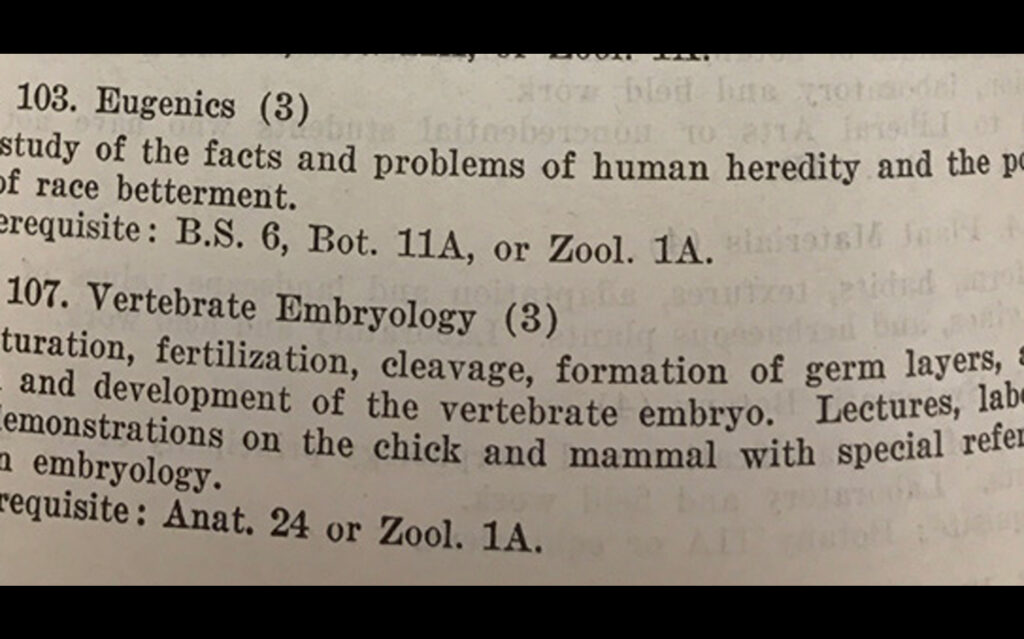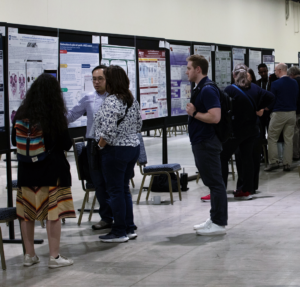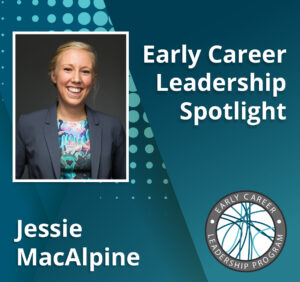Guest author Rori Rohlfs describes a unique classroom project for exploring the eugenic history of our field.
I was a fourth-year graduate student when I found myself asking a librarian for the archives of the journal The Annals of Eugenics. I got to that point by climbing back through a chain of references on fundamental statistical measures in my field of population genetics. I held the journal and flipped through the article titles and familiar author names, realizing that my field wasn’t so far removed from the turn-of-the-century eugenics movement. Feeling somewhat nauseous, I photocopied the article I was looking for and returned the journal quickly.
Now as a faculty member at San Francisco State University (SFSU), a public institution that puts social justice at the center of its mission, I continue to struggle with my field’s limited reckoning with our eugenic past. Can folks like me, who have built careers that grow from eugenics science, hold ourselves accountable for these roots as we continue scientific research? These questions become increasingly important in a political landscape where scientific ideas about genetic variation and difference are weaponized to support devastating policies, and the atrocities of racial injustice are staring us in the face.
As unarmed Black people are killed by police, and Black, Latinx, and Native American communities are disproportionately decimated by COVID19, masses of powerful voices are speaking out against racial injustice. We cannot let this moment pass us by without making substantive changes to eliminate institutional violence against Black people, people of color, and all marginalized groups. There is a particular need for those of us at the intersection of white privilege and scientific/educational privilege to listen to Black voices as we reflect on our personal and professional relationships to racism in terms of 1) how we benefit from racism, 2) how we contribute to racism and patterns of racialization, and 3) how we can take accountability for harms done. By understanding the harm caused, we are better positioned to address it.
In an effort to investigate that harm, I worked with SFSU students to explore the role of eugenics in the history of our field and institution. While the road to accountability will be long and arduous, I hope that this work sparks other scientists to action and brings us a bit further down that road.
The entangled roots of eugenics, statistics, and population genetics
The term eugenics was coined in 1883 by Francis Galton, a fellow of the Royal Society who’s credited with laying down foundational ideas in statistics, psychology, and criminology. Galton championed the emerging scientific field of eugenics and the political eugenics movement. Eugenics is rooted in the idea that a person’s genes determine their traits (e.g. height, disability, intelligence, sexuality, criminality), and that some trait variants are more valuable than others. This idea is inseparable from the idea that human trait diversity can be categorized into biologically distinct races, which follow a natural hierarchical order. In Angela Saini’s book Superior (2019), she clearly lays out the political implications: If a person’s station in life is determined by their own genetics, rather than social experience and access to resources, then inequities in power and wealth would be natural and inevitable. This brand of genetic determinism has been used to justify slavery, colonization, and other manifestations of racism and ableism for centuries. With this deterministic theoretical underpinning, eugenics seeks to “improve” the human species through selective breeding, specific immigration standards, and other social policies
Far from being a fringe pseudoscience, the field of eugenics was widely accepted in science. In 1910 Charles Davenport established the Eugenics Record Office at the renowned research institute of Cold Spring Harbor Laboratory. Through 1939, the Eugenics Record Office collected and published data to support eugenic policies of forced sterilization and immigration restrictions targeting people who were disabled, people of color, and/or poor. The results of eugenics research needed a reputable peer-reviewed academic journal venue. So in 1925, Karl Pearson, creator of the chi-squared test, p-value, and principal component analysis, established a prestigious journal for the field: The Annals of Eugenics. Other influential members of the academic elite aligned themselves with the eugenics movement, including central figures in the history of evolution theory like R.A. Fisher, Julian Huxley, and J.B.S. Haldane.
We still see the impact today through lines of reasoning and linguistic footprints. An emblematic example is statistical regression analysis. In his efforts towards the “improvement of the human breed,” Galton performed calculations intended to determine to what degree parents with a desired trait, such as “civic worth,” would reliably produce children with the same trait. These calculations needed to account for an observation that troubled Galton: offspring of parents with extreme trait values have, on average, less extreme traits than their parents [1]. The name he gave to his observation— “regression towards mediocrity”, now usually called regression to the mean—suggests his value judgment about the “quality of parentages” that go “far back towards mediocrity.” Galton’s term regression now describes the class of statistical techniques referred to as regression analysis, which continues to be central in statistics, and is used across disciplines from biology to economics to sociology.
Shifting names for the study of the genetic basis of human traits
Eugenic science and policy, largely developed in the United States and England, were implemented in the extreme by Nazi Germany. The explicit scientific field of eugenics lost support as the specific atrocities of the Nazi Holocaust came to light. Because of this, we may like to think that present-day fields like population and human genetics have totally departed from their eugenic predecessors. Yet, it’s easy to find threads of research continuing under different names. For example, in 1954 Annals of Eugenics changed its title to the Annals of Human Genetics, which is still publishing in 2020. Saini notes that the same individual scientists who performed genetic research “gently maneuver[ed] themselves out of eugenics into allied fields that studied human difference in less controversial and more rigorous ways, such as genetics.” Intentional tactics like these have led to a cultivated amnesia about our academic history. Yet, these individuals are our academic ancestors, and we cannot avoid being influenced by their intellectual legacy. These connections are seldom discussed, to the extent that they are unknown to most present-day geneticists. It was only through an accident that I stumbled on a connection, this when I had nearly earned a PhD. How can we be accountable for our past when we don’t know the history of our own fields?
Today, we are seeing a surge of well-funded studies seeking to determine the genetic basis of traits with clear, well-studied environmental influences like height, intelligence, sexual behavior, and income. These analyses have received numerous technical critiques that call into question the validity of the scientific inferences, noting that “while the benefits are far from obvious, the risks of such results being misinterpreted and misused are quite clear.” Yet, the persistence of these lines of inquiry belies a familiar preoccupation with inborn differences for traits of social consequence. As in the past, there are ideological stakes in these studies: if these studies did in fact prove that differences in income, for example, are fixed by genetics (genetic association studies are incapable of proving that), then egalitarian economic policies would be futile. The legacy of eugenics is apparent today in both our scientific research and our political context. Prestigious journals are publishing these studies as the political landscape includes openly eugenicist ideas and policies based on the alleged inferiority of some nations of individuals, backed up with horrific restrictive immigration policies, at a time when it needs to be said that Black Lives Matter.
Because genetic determinism is an implicit and stealth component of our academic inheritance, even well-meaning scientists working at respected institutions can unwittingly pursue research that supports eugenicist arguments. To avoid incurring more harm, it is crucial that we scientists understand and reckon with our past. Saini makes a compelling call-to-action: “Without ever really looking back to the past and asking how and where the idea of race [and eugenics] had been constructed in the first place, why it had been relentlessly abused—without questioning the motives of scientists such as Francis Galton, Karl Pearson, [R.A. Fischer, Julian Huxley, and J.B.S. Haldane]—in this glaring ‘absence of introspection,’ old ideas of race [and eugenics] could never completely disappear.” As a test case in examining an institution’s relationship with its eugenic past, three undergraduates and I embarked on a self-reflective history of the topic at San Francisco State University.
The “Eugenics” course was offered at SFSU until 1952, when “Human genetics” was first offered
The students went to the library to pore over archived paper copies of university bulletins. As amateur historians, we had a learning experience in the nature of archival records. Bulletins were not available for every year, and over time the information they included varied dramatically. Nonetheless, we found that “Eugenics” was offered through the Biology Department at SFSU starting at latest in 1926. The course description is informative: “Study of the facts and problems of human heredity and possibility of race betterment.” At the time, SFSU was San Francisco State Teachers College, so graduates were expected to use their education to teach the next generation. Positioning teachers to improve public support of eugenic principles was important to the mission of eugenics. Instilling eugenic reasoning into the broader population must have been highly valued as it was one of only 12 upper division elective courses.
“Eugenics” was offered for the last time in 1951, six years after the end of World War II. This lag time demonstrates how the academic community held on to eugenics, well after the genocide in Nazi Germany became public knowledge. Let’s take a moment to think about the impact of over a quarter-century of teaching students about “the facts and problems of human heredity and the possibility of race betterment.” Most of these students became teachers themselves, disseminating eugenic reasoning on to their students. It’s hard to say how many thousands of people were influenced by the ideas in this course. While my privilege prevents me from being able to speak to the experience of scientists of color who endured the course, I will speculate about the impact for white students. For white students, how did the scientific reasoning (however flawed) presented in this class bolster racism and internal bias over generations? How do those ingrained racist ideas influence a white police officer seeing a Black man? A white city planner deciding whether to zone for toxic industry in a Latinx neighborhood? A white scientist designing a curriculum for a genetics class today?
While “Eugenics” was not offered after 1951, a new course appeared in 1952, “Human genetics,” described as “Principle of inheritance as applied to man; the role of heredity and environment; population genetics.” From these course descriptions, we see consistent interest in human heredity with movement away from blatant race science, towards population genetics and environmental factors. We’re very curious about the specific comparative curricula of these courses, but syllabi were not archived. 
Beginning to envision an accountable scientific future
Some might be surprised to find this connection at SFSU, a university with a history rooted in progressivism, as evidenced in its mission statement that centers an “unwavering commitment to social justice.” Yet, eugenic thinking has pervaded the political spectrum, including progressive supporters like W.E.B. Du Bois and Margaret Sanger. Far from unique, the trajectory of the eugenics course at SFSU is likely common. We hope that this project inspires researchers at other universities to look into their own institutional histories. This type of research into university archives is quite feasible for a small team of dedicated undergraduates, perhaps especially those looking for a senior thesis or capstone project. A set of projects at different universities would illuminate the landscape and impact of eugenics course offerings.
While our findings confirmed my suspicions, it’s still jarring to see this history at my institution, conceptually related to the very Genetics class that I teach today. Once we are aware of these connections, what can we do to be accountable as well-intended, anti-racist heirs of this legacy? Our scientific training has provided us powerful tools of critical examination, tools which we can direct to investigate the ways our research, teaching, and scientific culture are influenced by our eugenic roots. Our small exploration here has led me to question ideas central to both my population genetics training (why is it so common for evolutionary models to assume a single fixed optimum value for a trait?), and the institutional legacy of how we teach genetics (why do we emphasize inheritance of Mendelian traits when we know the vast majority of traits are polygenic and influenced by environmental factors?).
By grappling with questions like these, we can begin a process of accountability, squaring up with our scientific past, and intentionally shaping our future. As one small step, I now attempt to address some of the harm caused by my university’s historic eugenics course in my own genetics course by explicitly discussing eugenics within a broader anti-racist and anti-eugenics curriculum. While we cannot sever the connections to our institutional and academic roots in eugenics, with a better understanding of our history, we will be better equipped to both respond to eugenic ideas as they re-emerge, and to create a scientific culture that values justice.
*
[1] As one explanation, people who are extremely tall (or short) typically have unusually extreme genetic and environmental factors that contribute to their stature. While their children may inherit genetic variants that lead to extreme stature, they are unlikely to experience the unusual environmental conditions that led to their parents’ height. So the children of very tall parents are typically shorter than their parents. Through his lens of genetic determinism, Galton minimized the role of environmental factors, instead explaining his observations as “The child inherits partly from his parents, partly from his ancestry,” going on to clarify that ancestry describes “the race at large.”
Acknowledgements: I’m deeply grateful to Brandon Ogbunu for conversations and insights that helped to shape this piece, as well as Niquo Ceberio, Graham Coop, Doc Edge, Imon Islam, Cristy Gelling, Milton Reynolds, Alex Safron, and Hannah Mariko Thorner for their helpful comments on earlier versions.
Update June 14, 2020
The following edit was made:
“As in the past, there are ideological stakes in these studies: if these studies did in fact prove that differences in income, for example, are fixed by genetics (genetic association studies are incapable of proving that) are explained by heritable genetics, rather than social and historical factors, then income disparities would be innate, and egalitarian economic policies would be futile.”
About the author:
 Rori Rohlfs is an Assistant Professor in the Department of Biology at San Francisco State University.
Rori Rohlfs is an Assistant Professor in the Department of Biology at San Francisco State University.





